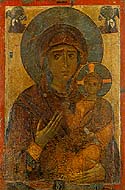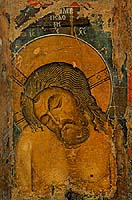|
Icons
An example is the Panagia Odigitria icon, a bilateral icon. Its most characteristic elements are its strength of expression and the emotional intensity that emanates from the figures. Its lines dominate and accentuate their faces. Its artistic excellence puts it among the great twelfth-century monumental wall-paintings, such as those at Kurbinovo and Agioi Anargyroi. But this apart, there is another reason why the icon is important. Its reverse side has the first known representation of a theme which we call 'The Man of Sorrows'. This iconographic theme compressed the Passion of Christ into a single icon, and was very popular in the Late Byzantine period. |
||
|
In the meantime, a fair number of other icons have been discovered. Thorough study of these will enrich our understanding of how portable icons of this period were painted. Thus it will fill out our picture of artistic activity at Kastoria. |
||
|

